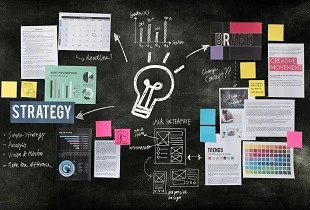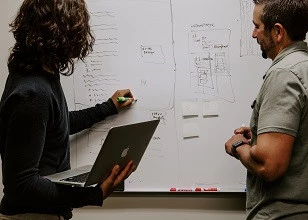Business model innovation meets hybrid work
How industry disruptions force business model transitions and how to manage these disruptions with digitalization
Add bookmark
Many industries are in a state of transformation. At the same time, new forms of work and hybrid working need to be organized. As part of my series on the trend map of business transformation and operational excellence, I take a closer look at the synergies of business model innovation and new work initiatives.
 Trend map for new work and business model innovation (Source - Software AG)
Trend map for new work and business model innovation (Source - Software AG)
Many industries are facing major challenges and upheavals that have a huge impact on their business models, necessitating business model innovation, but also on their production methods and work processes. Some examples include:
- Throughout the global Covid-19 pandemic, supplier and distribution networks have proven to be both a bottleneck and a vulnerability. In contrast, ‘hyperlocal operating models’ seek to focus their business activities, such as acquisition and provision of products and services, on a small geographical area.
- Climate change poses major challenges for companies requiring them to adapt their production methods and often their entire business model. ‘Neo-ecology‘ describes the major trend toward a resource-efficient, sustainable economy.
- The traditional retail industry is experiencing a continuous migration toward online retail. On the other hand, new business models are emerging to take up the fight against e-commerce, such as gastro formats with an experiential character at food retailers.
- At banks and other financial service providers, the closure of branches, and the success of online brokers and fintechs, are significantly changing the requirement profiles of employees.
The pandemic has also significantly changed working circumstances in many sectors. In addition to the massive demands on families to meet the challenges of the pandemic, we also see an increased flexibility for employees in where and when they are willing to work, which has given rise to hybrid-working models.
On the other hand, new, alternative forms of work are finding their way under the heading ‘new work’, a collective term that goes back to the social philosopher Frithjof Bergmann. In particular, the concept encompasses new forms of work that are shaped by today's knowledge and information society.
What synergies can these two megatrends develop and what benefits can result for both employees and organizations?
It is obvious that digitalization plays a major role in managing these changes. During the pandemic, many analogue, in-person contacts and interactions were no longer possible and were replaced by digital process steps. Workers were challenged to acquire new digital skills and to work remotely and in virtual collaboration. It is the common task of companies and employees to continuously improve digital competences, by applying the use of virtual conference systems, for example, and employee experience in a human-centric approach.
In addition to increasing competence in digital technologies, the business processes themselves are also changing as the need for agility and speed continue to increase. How can practitioners ensure that the 'new way of working' really reaches every employee and manage the roll out of role-specific knowledge?
Here too, digitalization offers new opportunities to raise employee enablement and involvement to a new level. Manual organizational handbooks have had their day. Digital portals allow role-specific knowledge access and enable very fast distribution of updates. Conversely, the digital distribution of policies and work instructions also allows the headquarters to analyze whether new operating procedures have been received, read and understood at any time. Typical areas of application can be found in all large, distributed organizations, such as retail companies, which sometimes had to react to altered Covid-19 guidelines every week and ensure that the regulations are implemented in every branch.
Rapid distribution and updating of knowledge are both vital to almost all industries and the automation of processes is the next step. In scenarios where routine work is predominant, workforce optimization tools can dynamically distribute the tasks to the employees. Digital process automation (DPA) platforms control the processing of end-to-end workflows. Documents become intelligent, meaning they recognize the necessary procedures themselves and find their way to the processor. Software robots are used in robotic process automation, where knowledge can be cast into rules so that recurring work steps can be automated. Everything gets measured and tracked with process and task mining technologies to improve these automatable processes permanently.
On the other hand, in scenarios where creativity and flexibility are required, we see several developments that are closely linked to ‘new work’ concepts. Those who think of innovation do not first think of hierarchies, but of inspiring working conditions, lively teams, autonomy and personal responsibility. These include:
- Cross-functional teams take the place of small-scale work and are in charge of end-to-end processes.
- Interdisciplinary teams that combine domain knowledge with technology knowledge act in an agile and self-determined way. They are the core building blocks of business processes that differentiate against competition.
- IT supports the work of the teams in various, increasingly intelligent forms and AI components are seamlessly integrated into business activities to support experts with specialized questions.
- Transforming AI from tools to teammates is a big trend supported by natural language processing (NLP) and virtual assistant technologies.
- ‘Objectives and key results’ (OKR) is widely used as a collaborative goal-setting methodology by teams and individuals to set ambitious goals with measurable results.
For many companies, it is a matter of defining the differentiating factors of their future business models and strengthening them with all their might, alongside investment in smart and motivated employees. On the other hand, the focus is on automating the non-differentiating processes as completely as possible to achieve cost advantages.































































